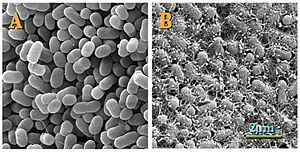Most available information relates to serotypesince it is easily differentiated biochemically from other E. coli strains. The reservoir of this pathogen appears to be mainly cattle and other ruminants such as camels. It is transmitted to humans primarily through consumption of contaminated foods, such as raw or undercooked ground meat products and raw milk. Faecal contamination of water and other foods, as well as cross-contamination during food preparation (with beef and other meat products, contaminated surfaces and kitchen utensils), will also lead to infection. Examples of foods implicated in outbreaks of E. coli O157:H7 include undercooked hamburgers, dried cured salami, unpasteurized fresh-pressed apple cider, yogurt, cheese and milk. An increasing number of outbreaks are associated with the consumption of fruits and vegetables (sprouts, lettuce, coleslaw, salad) whereby contamination may be due to contact with faeces from domestic or wild animals at some stage during cultivation or handling. EHEC has also been isolated from bodies of water (ponds, streams), wells and water troughs, and has been found to survive for months in manure and water-trough sediments. Waterborne transmission has been reported, both from contaminated drinking-water and from recreational waters.
Person-to-person contact is an important mode of transmission through the oral-faecal route. An asymptomatic carrier state has been reported, where individuals show no clinical signs of disease but are capable of infecting others. The duration of excretion of EHEC is about one week or less in adults, but can be longer in children. Visiting farms and other venues where the general public might come into direct contact with farm animals has also been identified as an important risk factor for EHEC infection.
 Ecoli
Ecoli
No comments:
Post a Comment